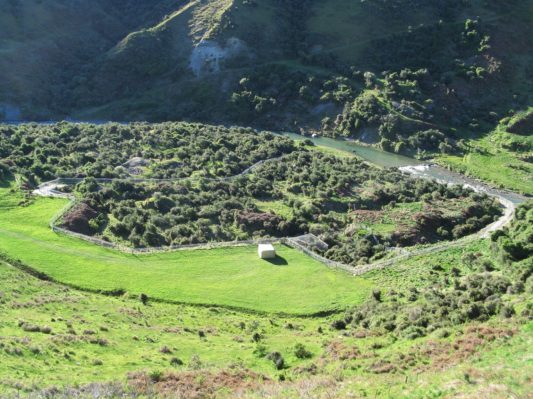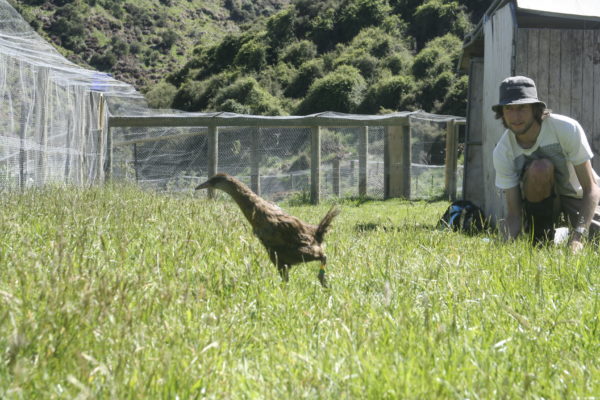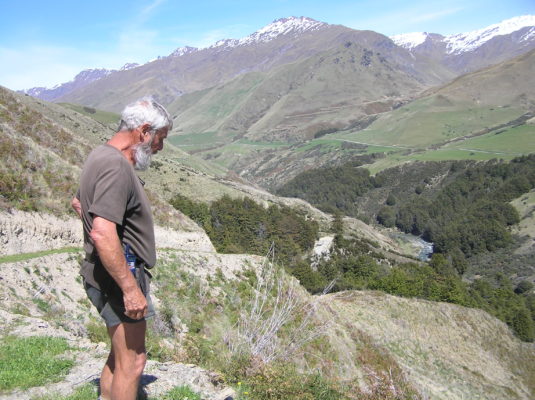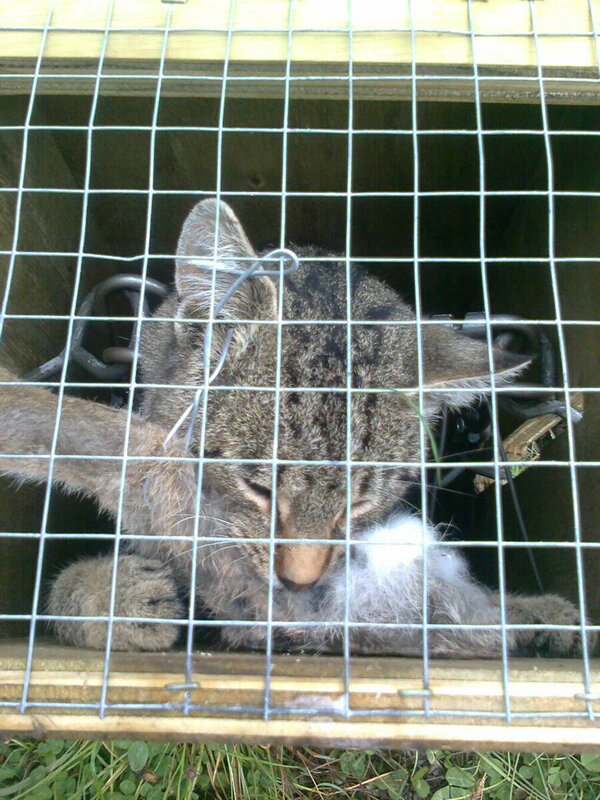With a vision to re-establish the once-common buff weka, Motatapu Station near Wanaka is tackling habitat restoration and predator control on an impressively large scale.
Just check out the numbers so far:
- 1,405,278 corrected trap nights (CTN – a ‘catch per effort’ adjustment that takes account of the uncertainty over how long an animal has been caught in a trap and the trap has therefore been offline.) since 2009 targeting stoats, ferrets, feral cats and rats.
- 3,126 target animals trapped
- 717 stoats
- 503 ferrets
- 273 weasels
- 230 cats trapped (and many others shot)
- 1,676 rats
- 3,8173 hedgehogs (not targeted but caught regardless).
What’s even more impressive, is that predator control on the ground is carried out by just three people – station supervisor Russell Hamilton, station manager Huntly McGregor and trapper John Fleming. Ecologist and environmental consultant, Dawn Palmer manages the trapping data and the weka translocation project.

“I crunch the numbers and write reports etc,” she explains. “We’re a lean team!”
“We’re very lucky to have John Fleming,” adds Russell. “He’s been a hunter and trapper all his life. He’s very experienced and extremely conscientious. We would have struggled over the years without him. He can read the subtleties of the environment. He’ll say ‘I reckon there’s a cat out there’ and sure enough he’ll get one, sometimes with the assistance of his predator dog Olive.”
Feral cats are a major problem at Motatapu.
“They’re right through the landscape,” says Russell. “They just keep coming. Every year we take the same number out. People save and release them. They’re everywhere – high and low. Huntly saw a cat pull a pukeko out of the sky – it just jumped up and pulled the pukeko down, it was dead before he could get to it.”
Dawn and Russell say a consensus is needed on how to deal with cats.
“We have giant cats here. The big old feral cats are huge – much bigger than you’d imagine.”

Motatapu Station, along with neighbouring pastoral leases Mt Soho, Coronet Peak and Glencoe Stations are all owned by Soho Properties, whose owners have a goal to create a predator-controlled mainland island and support Ngai Tahu in the reintroduction of the buff weka. Buff weka were once common throughout the eastern South Island and were reported to be efficient killers of rabbits last century – until stoats and ferrets were introduced and proceeded to wipe out the weka as well as hunting the rabbits.
In total 55,000 hectares of Soho Properties’ pastoral lease land is protected under a QE II National Trust covenant called ‘Mahu Whenua’.
Predator control is centred on 4,000 hectares of Motatapu Station and has been carried out since the Spring of 2009. Since then the control operation has expanded from 50 to 670 traps. Cage traps, conibears, DOC 200s and DOC 250s are all used. PAPP, a red blood cell poison which works similarly to carbon-monoxide poisoning, was briefly used against stoats.
“We’re constantly varying the approach,” says Russell. “We introduced ferret bedding into 100 tunnels as a lure. Trappers agree that the presentation of a different lure changes things and gets their interest. We got a number of ferrets straight off the bat, then it trailed off. It needs to be pulsed – perhaps timed with breeding season and the annual pulse of reinvasion.”
Dawn and Russell are keen to learn from everyone and compare.
“The knowledge base is growing all the time. We’ve very open to that learning. We do a lot of work with various researchers from the University of Otago, looking at lizards, bird counts and plants.”

Landscape restoration at Motatapu has involved destocking, fencing and planting.
“We’ve fenced all the covenants and destocked major areas,” says Russell, “Even where farming is still carried out, we’ve fenced riparian zones, wetlands and regenerating gullies. We’ve planted a variety of native trees to create useful habitat. Improved habitat is the largest factor for the recovery of birds.”
The weka project, carried out as a joint venture with Ngai Tahu and with the support of the Department of Conservation, is just part of the bigger restoration vision, Dawn and Russell explain.
“We’re interested in birdlife in general. We’re trying to get the degraded biodiversity back. We’ve removed cattle and fenced the beech forest margins and can see natural regeneration. It’s also very obvious on the manuka shrublands slope on the north face of Motatapu Valley where there’s been a prolific recovery.”
Russell calculates that 1 million trees have been planted so far.
“Biodiversity is improving on all the properties, just from stock removal,” Russell says. “It’s happening everywhere and the planting and trapping programme has allowed a lot of native birds to come back. Shrubland and bush birds are now obvious, with species including bellbird, fantail, tomtit, grey warbler, brown creeper, kea, falcon and rifleman. Tui have come back, some kakariki have been heard and there is a historical sighting of whio/blue duck from the Fernburn to the east.”
Paul van Klink and Hoki, his trained ‘whio dog’ searched the North Branch and main Motatapu a while back.
“The river habitat is great but there are no whio here yet. The value of making the landscape safe is that there will be natural dispersal and birds will stay. There are a lot of falcon throughout the property and that reflects the country getting healthier.”
After some initial predator control, a trial release of buff weka was made in 2012.
“Jim Watts, a University of Otago masters student, carried out research on post-release dispersal of the buff weka. We gained a lot of information of what the weka are likely to do, but unfortunately predation made a founding population unsustainable.”
While those initial weka all fell victim to predators, Motatapu’s predator control programme has since been expanded and the Motatapu team, along with Ngai Tahu and DOC continue to work towards an eventual successful release.

“After 10 years, the Station’s habitat is flourishing. It will be so much better for the next release,” say Dawn and Russell.
The massive landscape scale predator control carried out by other groups in the Matukituki Valley, as well as on Motatapu itself, has hopefully been making an impact on predator numbers since that initial trial release.
“Trapping abundance indices show the impact of suppression,” Dawn explains. “Stoat indices have dropped. At the time of the first weka release there were 0.12 stoat captures per 100 corrected trap nights. Abundance indices have been in steady decline since then with this year’s summer peak just 0.03 C/100CTN. Those results suggest that we’ve moved towards sustained suppression of stoats.”
Ferret abundance indices have been lowered but Dawn and Russell remain cautious and have set themselves the goal of reducing ferrets numbers further.
“Weka are a ‘stinky, shouty bird’,” says Dawn. “They’re easy for a rogue animal to smell and this makes them vulnerable to mustelids.”
Like all of our native birds, weka have evolved to cope with aerial predators – other birds which rely on sight, not scent, for hunting. Kiwi and kakapo, for example, are also known to have a distinctive aroma that’s easily detected by mammalian predators.
“Currently we’re going through a consultation process with DOC and Ngai Tahu about what’s next for the weka,” says Dawn. “There’s interest in another release.”
“It’s at least 12 months away,” Russell adds. “July 2019 at the earliest.”
“But we need to achieve greater confidence in our ferret control before decisions can be made for another release,” Dawn suggests.
If weka can successfully establish at Motatapu Station, it will take the restoration work up another level.
“Weka are amazing restoration engineers,” Dawn explains. “They’re important seed dispersers.”
“They eat a wealth of seeds and scrape the ground. In spring you’d swear that a cultivator has been through the way they turn it all over!” Russell confirms.
As with any restoration project, there have been challenges and disappointments.
“There are challenges with rogue animals and reinvasion,” says Russell. “It’s really tough at times and soul-destroying. It’s important not to lose heart at the setbacks and predator events. Over time there’s more recovery and local dispersal of species currently benefiting from control.”
Here’s hoping that sometime soon buff weka will be one of those recovery success stories, dispersing throughout Motatapu and the wider Matukituki Valley, cultivating the soil once more, spreading seeds and digging out those rabbits.

